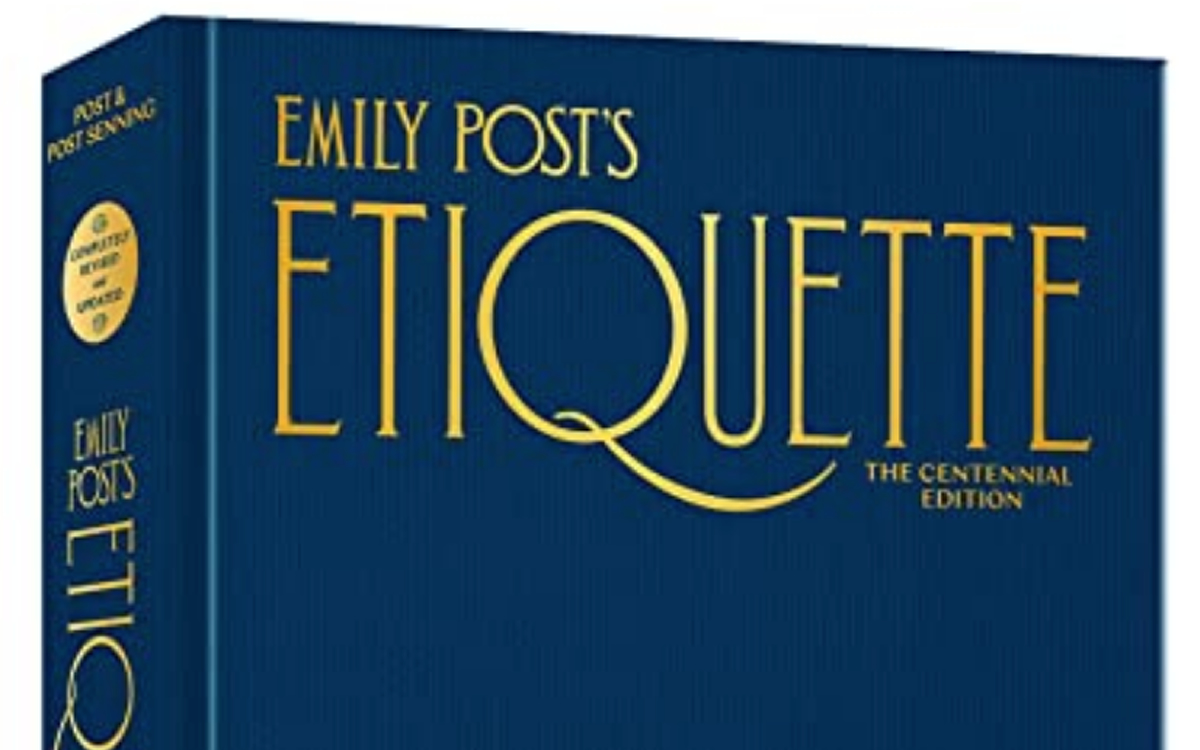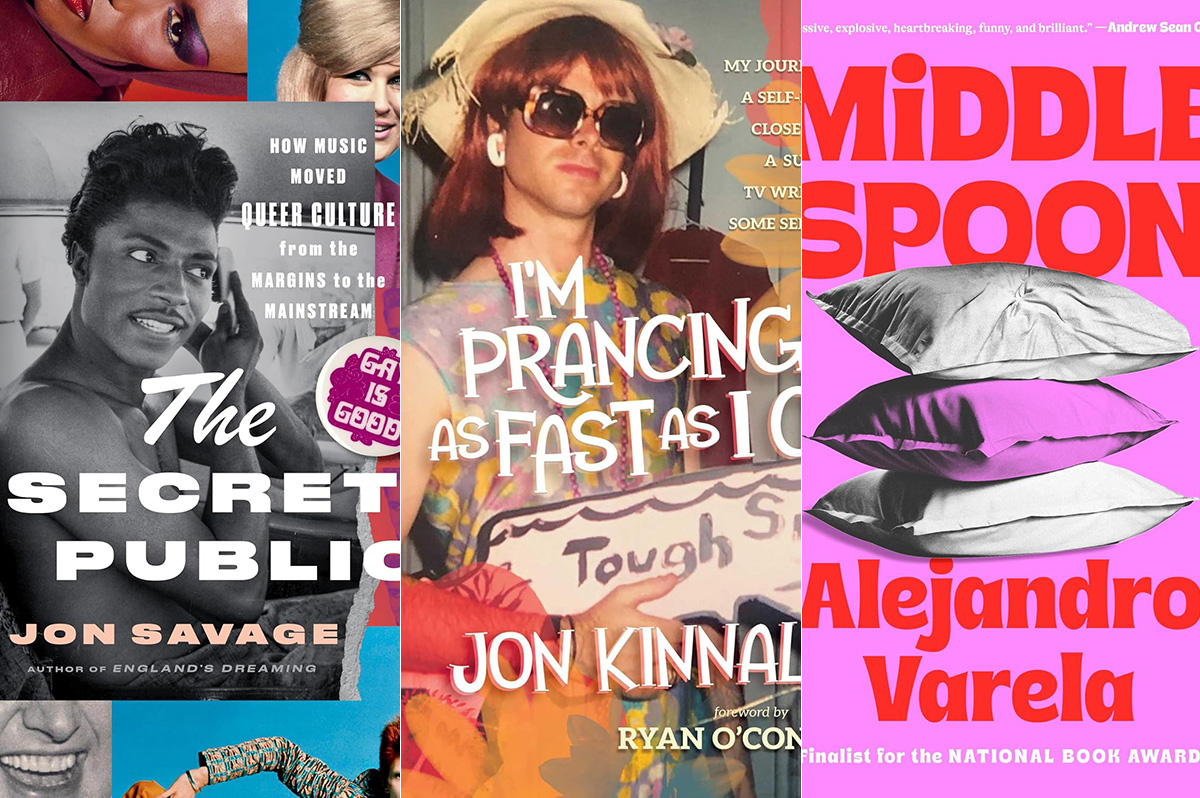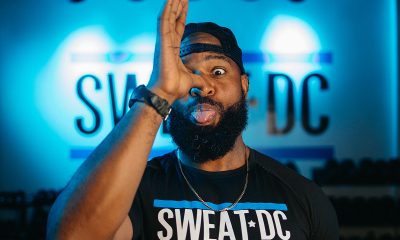Books
20th edition of Emily Post’s ‘Etiquette’ offers updated advice on pronouns and much more
A guide for daily life ‘with all its successes and mishaps’

Some families manage bakeries, nurseries, or vineyards.
For Daniel Post Senning, great-great grandson of Emily Post and an Emily Post Institute co-president, and Lizzie Post, great-great granddaughter of Emily Post and an Emily Post Institute co-president, etiquette is the family business.
The Emily Post Institute, based in Waterbury, Vt., conducts seminars and trainings. It partners with businesses and nonprofit groups to “bring etiquette and manners to a wide audience,” according to its website.
When you think of etiquette, you’re likely to be transported to Downton Abbey. Butlers, finger bowls, the dancing school lessons you hated as a kid – stuffy, rich (usually white, hetero) people at formal dinners managing a zillion salad forks – come to mind.
But, for Post and Senning, who co-host the popular, entertaining podcast “Awesome Etiquette,” etiquette is as far from being an ossified, exclusionary code of manners as we are from being the Dowager having tea at Downton.
Emily Post, the acclaimed etiquette maven, published her first book on etiquette, “Etiquette in Society, in Business, in Politics and at Home,” in 1922.
Post’s seminal book, considered by many to be the “holy writ” of etiquette (and stolen from libraries almost as frequently as the Bible), has been revised by Post herself and her descendants during the past century to evolve with changing times.
“Emily Post’s Etiquette, The Centennial Edition” by Lizzie Post and Daniel Post Senning, the 20th edition of Emily Post’s “Etiquette,” is just out. (For info on “Emily Post’s Etiquette, the Centennial Edition,” the Awesome Etiquette podcast and the Emily Post Institute, visit emilypost.com.)
The “Centennial Edition” has lively, up-to-date advice and discussion on everything in life in the early 2020s from the use of “mx” as a title to grief to respecting people’s pronouns to how to get company to stop making bigoted “jokes” to how to handle an inebriated guest.
From the get-go, Emily Post, who was born in Baltimore in 1872 during the Gilded Age and died in 1960, didn’t view etiquette as restrictive or exclusionary. “As Emily explained,’” Post and Senning write, “etiquette is not some rigid code of manners; it’s simply how persons’ lives touch one another.”
If you browse some editions of Emily Post’s books (as this reporter has), you won’t find schoolmarmish directives or ethereal descriptions of the etiquette gods’ mannered lives on Mount Olympus.
You’ll find daily life “with all its successes and mishaps,” Post and Senning write, “With tales like ‘How a Dinner Can Be Bungled’ and characters such as Mrs. Worldly, Constance Style, Mrs. Kindhart and the Onceweres.”
Emily Post painted relatable pictures of what to do and not to do, Post and Senning write.
Though Emily Post wouldn’t have known what a smartphone or social media were, her etiquette “still aims to equip you,” write Post and Senning, “with a sense of confidence and preparedness for some of the situations you’ll encounter at home, at work, in your social life, and when you’re out and about.”
Despite claims that etiquette is dead, it is very much alive, say Post and Senning.
Steven Petrow, an award-winning journalist and expert on civility and manners, agrees. “I’m always surprised by how timely Emily Post’s advice continues to be,” Petrow, who is gay, said in an email to the Blade. “Recently, I wrote about ‘monkeypox manners,’ and cited Mrs. Post’s timeless advice about respect, consideration and honesty in our social interactions, which includes those in the bedroom.”
Post and Senning graciously took time out from their busy schedules (the launch of the “Centennial Edition,” hosting their podcast – along with their other work with the Emily Post Institute) to talk with the Blade over the phone in separate interviews.
“Emily Post’s Etiquette, The Centennial Edition” was a Herculean labor of writing and editing for Post and Senning. It took a year to write the book, Post said. And, then there was all of the time spent to ensure that the book was carefully edited.
“I would write,” said Post, 40, who manages the Institute’s publishing efforts, “Dan would come in and help me edit the book.”
It was intense, “day-to-day” labor for her and Senning (along with their other work), Post said. “I’m grateful to all the people who were willing to have their lives disrupted while we worked on it,” she added.
Etiquette has been used for less than gracious purposes, Post said. “It can easily be exclusive.”
The Post family believes that etiquette is based on the principles of consideration, respect and honesty. This may sound abstract. But these principles aren’t empty words. They have a profound impact in the real world.
Before joining the Emily Post Institute in 2008 when he was 30, Senning worked in the performing arts, touring with the Laurie Cameron Company in Los Angeles.
Today, Senning, who lives in Duxbury, Vt., with his wife, Puja and their three children Anisha, Arya, and William, manages the Institute’s training programs. He has co-authored several books on etiquette covering topics from business to digital manners and regularly speaks with media outlets about business, technology, and dining etiquette.
In 2009, same-sex marriage became legal in Vermont. “Then, before the Supreme Court same-sex marriage ruling,” he said, “we were in the vanguard. We got questions about how to respond to same-sex weddings,” Senning added.
The Institute’s response was to note how normal civil unions were, Senning said, and that same-sex weddings weren’t different from hetero weddings.
“If you’re invited to a civil union, reply,” Senning recalled the Institute advising, “let people know if you can or can’t attend.”
Senning loved the “normalization” of the response. “It was really affirming to me,” he said.
Etiquette isn’t only for happy times. It’s called on when things get rough.
“Etiquette has a role in hard times,” Post, who’s been an American Express spokesperson and written columns for publications ranging from “Broccoli Magazine” to “Women’s Running,” said.
Many go through hard times from losing a job to being ill to grieving, she added. Emily Post may have written on etiquette a century ago, but her thoughts on grief ring as true on an iPad screen as they did then in a hardback book.
“At no time does solemnity so possess our souls as when we stand deserted at the brink of darkness into which our loved one has gone,” Emily Post wrote in 1922, “And the last place in the world where we would look for comfort at such a time is in the seeming artificiality of etiquette; yet it is in the moment of deepest sorrow that etiquette performs its most vital and real service.”
“All set rules for social observance have for their object the smoothing of personal contracts,” Emily Post added, “and in nothing is smoothness so necessary as in observing the solemn rites accorded our dead.”
Etiquette can help people grieve together in community through writing a condolence note, attending a funeral or another act of common grief, Lizzie Post said.
If you’ve suffered a loss, it can be incredible to realize the impact a loved one has had when you receive condolence notes or see so many people at a memorial service.
There’s a new trend where you can take part in the grief without going to a funeral, Post, who lives in her native state of Vermont, said. “When someone dies, for example, you raise a glass at five o’clock to honor them.”
Sometimes you have to use etiquette to stand against prejudice. If someone’s telling a racist or anti-queer joke at your dinner table, you’ll need to say, “‘I’m sorry. This is not a joke for this table,’” Post said.
While etiquette counsels against rudeness, safety trumps etiquette, Post and Senning have said on the Awesome Etiquette podcast and in the “Centennial Edition.”
Tolerance doesn’t mean tolerating an unwanted hug, an inappropriate touch or being “othered,” said Post, who has co-authored and authored etiquette books on topics ranging from weddings to legalized cannabis use.
Take hugging. “We talk about how to ask for a hug and how to block a hug,” Post said.
Etiquette experts, like the rest of us, take time off. On vacation, Post, co-author and narrator with Kelly Williams Brown of the Audible Original “Mistakes were Made” (think etiquette meets “Broad City”), doesn’t want to be rude to people. “But, sometimes, I don’t want to analyze behavior,” she said, “I just want to act.”
For info on the fascinating life of Emily Post, go to “Emily Post: Daughter of the Gilded Age, Mistress of American Manners” by Laura Claridge.
Books
This gay author sees dead people

‘Are You There Spirit? It’s Me, Travis’
By Travis Holp
c.2025, Spiegel and Grau
$28/240 pages
Your dad sent you a penny the other day, minted in his birth year.
They say pennies from heaven are a sign of some sort, and that makes sense: You’ve been thinking about him a lot lately. Some might scoff, but the idea that a lost loved one is trying to tell you he’s OK is comforting. So read the new book, “Are You There, Spirit? It’s Me, Travis” by Travis Holp, and keep your eyes open.

Ever since he was a young boy growing up just outside Dayton, Ohio, Travis Holp wanted to be a writer. He also wanted to say that he was gay but his conservative parents believed his gayness was some sort of phase. That, and bullying made him hide who he was.
He also had to hide his nascent ability to communicate with people who had died, through an entity he calls “Spirit.” Eventually, though it left him with psychological scars and a drinking problem he’s since overcome, Holp was finally able to talk about his gayness and reveal his otherworldly ability.
Getting some people to believe that he speaks to the dead is still a tall order. Spirit helps naysayers, as well as Holp himself.
Spirit, he says, isn’t a person or an essence; Spirit is love. Spirit is a conduit of healing and energy, speaking through Holp in symbolic messages, feelings, and through synchronistic events. For example, Holp says coincidences are not coincidental; they’re ways for loved ones to convey messages of healing and energy.
To tap into your own healing Spirit, Holp says to trust yourself when you think you’ve received a healing message. Ignore your ego, but listen to your inner voice. Remember that Spirit won’t work on any fixed timeline, and its only purpose is to exist.
And keep in mind that “anything is possible because you are an unlimited being.”
You’re going to want very much to like “Are You There, Spirit? It’s Me, Travis.” The cover photo of author Travis Holp will make you smile. Alas, what you’ll find in here is hard to read, not due to content but for lack of focus.
What’s inside this book is scattered and repetitious. Love, energy, healing, faith, and fear are words that are used often – so often, in fact, that many pages feel like they’ve been recycled, or like you’ve entered a time warp that moves you backward, page-wise. Yes, there are uplifting accounts of readings that Holp has done with clients here, and they’re exciting but there are too few of them. When you find them, you’ll love them. They may make you cry. They’re exactly what you need, if you grieve. Just not enough.
This isn’t a terrible book, but its audience might be narrow. It absolutely needs more stories, less sentiment; more tales, less transcendence and if that’s your aim, go elsewhere. But if your soul cries for comfort after loss, “Are You There, Spirit? It’s Me, Travis” might still make sense.
The Blade may receive commissions from qualifying purchases made via this post.
Books
‘Dogs of Venice’ looks at love lost and rediscovered
A solo holiday trip to Italy takes unexpected turn

‘The Dogs of Venice’
By Steven Crowley
c.2025, G.P. Putnam & Sons
$20/65 pages
One person.
Two, 12, 20, you can still feel alone in a crowded room if it’s a place you don’t want to be. People say, though, that that’s no way to do the holidays; you’re supposed to Make Merry, even when your heart’s not in it. You’re supposed to feel happy, no matter what – even when, as in “The Dogs of Venice” by Steven Rowley, the Christmas tinsel seems tarnished.

Right up until the plane door closed, Paul held hope that Darren would decide to come on the vacation they’d planned for and saved for, for months.
Alas, Darren was a no-show, which was not really a surprise. Three weeks before the departure, he’d announced that their marriage wasn’t working for him anymore, and that he wanted a divorce. Paul had said he was going on the vacation anyhow. Why waste a perfectly good flight, or an already-booked B&B? He was going to Venice.
Darren just rolled his eyes.
Was that a metaphor for their entire marriage? Darren had always accused Paul of wanting too much. He indicated now that he felt stifled. Still, Darren’s unhappiness hit Paul broadside and so there was Paul, alone in a romantic Italian city, fighting with an espresso machine in a loft owned by someone who looked like a frozen-food spokeswoman.
He couldn’t speak or understand Italian very well. He didn’t know his way around, and he got lost often. But he felt anchored by a dog.
The dog – he liked to call it his dog – was a random stray, like so many others wandering around Venice unleashed, but this dog’s confidence and insouciant manner inspired Paul. If a dog could be like that, well, why couldn’t he?
He knew he wasn’t unlovable but solo holidays stunk and he hated his situation. Maybe the dog had a lesson to teach him: could you live a wonderful life without someone to watch out for, pet, and care for you?
Pick up “The Dogs of Venice,” and you might think to yourself that it won’t take long to read. At under 100 pages, you’d be right – which just gives you time to turn around and read it again. Because you’ll want to.
In the same way that you poke your tongue at a sore tooth, author Steven Rowley makes you want to remember what it’s like to be the victim of a dead romance. You can do it here safely because you simply know that Paul is too nice for it to last too long. No spoilers, though, except to say that this novel is about love – gone, resurrected, misdirected – and it unfolds in exactly the way you hope it will. All in a neat evening’s worth of reading. Perfect.
One thing to note: the Christmas setting is incidental and could just as well be any season, which means that this book is timely, no matter when you want it. So grab “The Dogs of Venice,” enjoy it twice with your book group, with your love, or read it alone.
The Blade may receive commissions from qualifying purchases made via this post.

Santa will be very relieved.
You’ve taken most of the burden off him by making a list and checking it twice on his behalf. The gift-buying in your house is almost done – except for those few people who are just so darn hard to buy for. So what do you give to the person who has (almost) everything? You give them a good book, like maybe one of these.
Memoir and biography
The person who loves digging into a multi-level memoir will be happy unwrapping “Blessings and Disasters: A Story of Alabama” by Alexis Okeowo (Henry Holt). It’s a memoir about growing up Black in what was once practically ground zero for the Confederacy. It’s about inequality, it busts stereotypes, and yet it still oozes love of place. You can’t go wrong if you wrap it up with “Queen Mother: Black Nationalism, Reparations, and the Untold Story of Audley Moore” by Ashley D. Farmer (Pantheon). It’s a chunky book with a memoir with meaning and plenty of thought.
For the giftee on your list who loves to laugh, wrap up “In My Remaining Years” by Jean Grae (Flatiron Books). It’s part memoir, part comedy, a look back at the late-last-century, part how-did-you-get-to-middle-age-already? and all fun. Wrap it up with “Here We Go: Lessons for Living Fearlessly from Two Traveling Nanas” by Eleanor Hamby and Dr. Sandra Hazellip with Elisa Petrini (Viking). It’s about the adventures of two 80-something best friends who seize life by the horns – something your giftee should do, too.
If there’ll be someone at your holiday table who’s finally coming home this year, wrap up “How I Found Myself in the Midwest” by Steve Grove (Simon & Schuster). It’s the story of a Silicon Valley worker who gives up his job and moves with his family to Minnesota, which was once home to him. That was around the time the pandemic hit, George Floyd was murdered, and life in general had been thrown into chaos. How does someone reconcile what was with what is now? Pair it with “Homestand: Small Town Baseball and the Fight for the Soul of America” by Will Bardenwerper (Doubleday). It’s set in New York and but isn’t that small-town feel universal, no matter where it comes from?
Won’t the adventurer on your list be happy when they unwrap “I Live Underwater” by Max Gene Nohl (University of Wisconsin Press)? They will, when they realize that this book is by a former deep-sea diver, treasure hunter, and all-around daredevil who changed the way we look for things under water. Nohl died more than 60 years ago, but his never-before-published memoir is fresh and relevant and will be a fun read for the right person.
If celeb bios are your giftee’s thing, then look for “The Luckiest” by Kelly Cervantes (BenBella Books). It’s the Midwest-to-New-York-City story of an actress and her life, her marriage, and what she did when tragedy hit. Filled with grace, it’s a winner.
Your music lover won’t want to open any other gifts if you give “Only God Can Judge Me: The Many Lives of Tupac Shakur” by Jeff Pearlman (Mariner Books). It’s the story of the life, death, and everything in-between about this iconic performer, including the mythology that he left behind. Has it been three decades since Tupac died? It has, but your music lover never forgets. Wrap it up with “Point Blank (Quick Studies)” by Bob Dylan, text by Eddie Gorodetsky, Lucy Sante, and Jackie Hamilton (Simon & Schuster), a book of Dylan’s drawings and artwork. This is a very nice coffee-table size book that will be absolutely perfect for fans of the great singer and for folks who love art.
For the giftee who’s concerned with their fellow man, “The Lost and the Found: A True Story of Homelessness, Found Family and Second Chances” by Kevin Fagan (One Signal / Atria) may be the book to give. It’s a story of two “unhoused” people in San Francisco, one of the country’s wealthiest cities, and their struggles. There’s hope in this book, but also trouble and your giftee will love it.
For the person on your list who suffered loss this year, give “Pine Melody” by Stacey Meadows (Independently Published), a memoir of loss, grief, and healing while remembering the person gone.
LGBTQ fiction
For the mystery lover who wants something different, try “Crime Ink: Iconic,” edited by John Copenhaver and Salem West (Bywater Books), a collection of short stories inspired by “queer legends” and allies you know. Psychological thrillers, creepy crime, cozies, they’re here.
Novel lovers will want to curl up this winter with “Middle Spoon” by Alejandro Varela (Viking), a book about a man who appears to have it all, until his heart is broken and the fix for it is one he doesn’t quite understand and neither does anyone he loves.
LGBTQ studies – nonfiction
For the young man who’s struggling with issues of gender, “Before They Were Men” by Jacob Tobia (Harmony Books) might be a good gift this year. These essays on manhood in today’s world works to widen our conversations on the role politics and feminism play in understanding masculinity and how it’s time we open our minds.
If there’s someone on your gift list who had a tough growing-up (didn’t we all?), then wrap up “I’m Prancing as Fast as I Can” by Jon Kinnally (Permuted Press / Simon & Schuster). Kinnally was once an awkward kid but he grew up to be a writer for TV shows you’ll recognize. You can’t go wrong gifting a story like that. Better idea: wrap it up with “So Gay for You: Friendship, Found Family, & The Show That Started It All” by Leisha Hailey & Kate Moennig (St. Martin’s Press), a book about a little TV show that launched a BFF-ship.
Who doesn’t have a giftee who loves music? You sure do, so wrap up “The Secret Public: How Music Moved Queer Culture from the Margins to the Mainstream” by Jon Savage (Liveright). Nobody has to tell your giftee that queer folk left their mark on music, but they’ll love reading the stories in this book and knowing what they didn’t know.
The Blade may receive commissions from qualifying purchases made via this post.

















